Katharinenkirche (Muhu)
Coordinates: 58 ° 36 ′ 14 ″ N , 23 ° 13 ′ 30 ″ E
The Katharinenkirche is the Evangelical Lutheran towerless parish church in Muhu in Estonia (also called the village church of Liiva).
The early Gothic Katharinenkirche belongs to the indigenous group of Saare-West churches. Saint Catherine of Alexandria is regarded as their patron saint . The church on the 200 km² island of Muhu is mentioned for the first time in 1267 in the chronicles of Hermann von Wartberge (1330-1380). In Estonia , the churches of Karja, Muhu and Pöide are considered to be an architectural and historical group that embodies the heyday of Gothic architecture in Saaremaa .
The building is considered to be one of the most architecturally complete and stylish country churches of the Estonian Middle Ages. The high outer walls and the roof create a building with slim proportions. A considerably narrower and lower choir adjoins the single-nave nave in the east, and this is followed by a smaller rectangular choir closure, which is lower than the choir area. This gradation of the building brings an architectural rhythm into the building mass. The tracery of the church windows reveals a context with the cathedral Gothic of Western Europe. The current appearance of the church is roughly the same as the original.
The two high, dome-like domical vaults decorated with beaded ribs and the simple cross vault in the chancel give the interior of the single-nave nave a special character. In the neatly crafted stone decor, figures and plant ornaments, which are characteristic of the churches of Karja and Pöide on Saaremaa, which were built around the same time, are almost completely missing.
The most interesting part of the interior is made up of the fragments of the wall painting, mainly preserved in the choir, dating from the end of the 13th century. The examples of the paintings in the church of Muhu are sought in Gotland, where strong outlines and Byzantine influences were characteristic of stained glass. The paintings, plastered over after the Reformation, were rediscovered in 1913. The oldest painting made using the fresco technique is that of the west wall. The round window there was possibly only brought in after the completion of the church. The paintings made in Secco technique are connected to the life of Christ. On the walls of the choir there are 12 prophets, the 12 apostles and angels. Only the fragments of images of the apostles and angels have been preserved. On the north wall of the choir there are images of Peter and John the Baptist.
The Renaissance-style pulpit is one of the oldest in the country and was made by Balthasar Raschky in 1627. The altar painting is from an earlier altar. The classicistic altar was completed in 1827 by Nommen Lorentzen.
In the church and in the churchyard there are trapezoidal tombstones with pagan symbols that are otherwise only known from the medieval churches and church gardens on Saaremaa and in Läänemaa (Westland). The grave slab in the doorway leading from the west wall to the tower is of particular interest. It is one of two tombstones preserved in Estonia from the 12th-13th centuries. Century depicting human figures. The youngest grave slab is on the wall next to the main entrance. Her text reads: "Here Johannes from Gotland has laid himself to rest, prays for him", which could point to the creator of the wall paintings.
The roof, which was destroyed in 1941, was not replaced until 1958. The empty church was used again from 1989. Renovations began in 1993 with funding from the diocese of Växjö (Sweden), and the church was consecrated again on May 22, 1994. In 2005 the church had 100 members.



